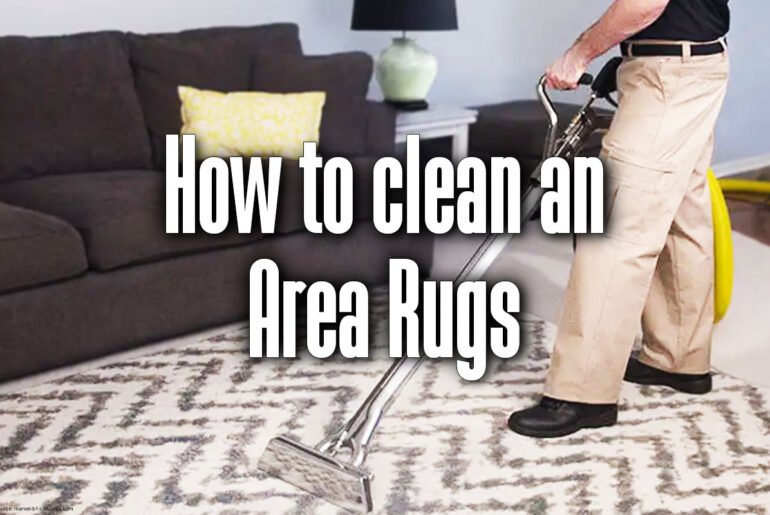Area Rugs are a wonderful choice to enhance the look of your patio space and give your patio a sophisticated appeal. Follow these easy methods for basic care, deep cleaning, and stain removal to keep your area rugs looking great. Plus, learn how to care for different sorts of area rugs correctly.
Area rugs bring warmth, color, and pattern to a space while also dividing it into sections. However, along with area rugs come stains and dirt, so it’s critical to understand how to clean an area rug.
Identifying the material of your area rug is the first step to cleaning it. This is critical in extending its life since various materials need varying cleaning processes and materials. Our area rug washing tutorial will educate you on the many forms of rugs and provide advice and instructions for area rug cleaning and stain removal.
Basic Area Rug Care
The best technique to clean an area rug depends on the size, construction, and material. Large area rugs, like wall-to-wall carpets, should be treated in the same way. That implies that most rugs will benefit from the following care process:
- Remove the dirt from large area rugs using a vacuum: Regular vacuuming is an essential procedure for rug cleaning, just as it is for carpet. If you’re vacuuming a reversible rug, both sides should be vacuumed. It also removes the grit and grime that can cause your rug to deteriorate prematurely. Make sure no fringe is vacuumed. (To prevent tangled the long fibers, turn off the beater bar when vacuuming a shag rug.)
- Brush out pet hair: After a vacuum, pet hair may be left behind. Use a firm brush to remove the hair in the direction of the rug’s nap.
- Rugs should be turned every year: Area rugs may be damaged by foot traffic and the sun. To even out the wear, rotate them once or twice a year.
- Shake tiny area rugs: If the rug is small enough, go outside and shake it or beat it violently to clean grit and dirt. If you live in an area with rules about shaking rugs outside, check your local legislation first.
Material-by-Material Guide for Rug Cleaning
Rugs of different types require different levels of care. For easy access, file away the rug’s care tags. Pay close attention to the producer’s cleaning instructions for the rug and use a rug shampooer or a cleaning machine. Follow these suggestions for caring for particular rugs.
How to Clean Woven or Braided Rugs
Before and after cleaning, check rugs for seeping or fraying stitching. To discover whether tiny braided rugs are washable, check their labels. Place them in a zippered or mesh laundry bag if they are. Wash under cool running water on a mild cycle, rinsing well. Dry at low temperature for tumbling.
Place large braided rugs on a concrete floor or vinyl or beneath an old blanket to clean them. Use the sponge commercial carpet cleaning foam from The Home Depot ($5) to cover the area and massage it according to the manufacturer’s instructions. Finish by either rinsing or vacuuming. Before replacing the rug on the floor, make sure it is completely dry.
How to Antique, Clean Hand-Knotted, and Oriental Rugs
Because they’re used in high-traffic areas and kitchens, Antique and Persian runners may require more care than other types of flooring. As with carpets and wool area rugs, clean a new Oriental rug using a vacuum. When cleaning delicate vintage or antique carpets, use particular attention. Keep them safe from the vacuum by laying a piece of nylon screen over the rug and placing weights on top of it. With the screen over the rug, vacuum over it. Another option is to use a piece of nylon mesh ($5, Hobby Lobby) to cover the vacuum attachment and change the mesh from time to time as dirt builds up. Once a year, have these rugs professionally cleaned. Rotate rugs to ensure uniform wear, and expose them to the sun only when necessary.
Editor’s Tip: While buying antique rugs, learn as much as you can about the rug’s fiber and construction from the seller—request care instructions.
How to Clean Rush, Grass Rugs, Sisal, and Coir
Rugs composed of Natural-fiber rugs, such as coir, sisal, rush, and grass, have an open weave that allows dirt to filter through to the floor below. They’re quite common as welcome mats and mudroom rugs. Periodically vacuum the rug, removing it for a thorough vacuuming of the floor beneath. Most of the rugs are reversible; if so, turn them over whenever you vacuum for uniform wear.
Leave a room-size natural-fiber rug in place to clean stains or discolorations on it. Plastic drop cloth and towel it to prevent damage to the floor. With a soft brush dampened in soapy water, scrub the marks away. Rinse off with clear water. Cover the wet area with a towel. Blot away the moisture as much as possible after cleaning. Use a portable fan or a hairdryer to speed up the drying process. To clean, move small rugs to a protected surface or counter. Water causes the fibers to weaken; therefore, work quickly and thoroughly to increase the life of these rugs.
Some natural-fiber rugs are made up of sewn squares. Consider purchasing a few additional squares or a smaller size of the same rugs. If a rug square becomes completely stained, cut the threads that keep it in place and replace them with a new square. Use heavy-duty carpet thread to hand-stitch it in place.
How to Hair-on Hides, Sheepskin, and Clean Fur
Shake unscented sheepskin, talcum powder on fur, and hair-on-hide rugs, and leave for several hours. Shake the hair out after brushing it with talcum powder. Do this procedure several times for each length of fur. To clean the back of this sort of carpet, use a clean white cloth dampened with lukewarm soapy water. Wipe the surface clean of any stains or spills. Rinse with a cloth by dipping it into clean water and then letting it dry completely before replacing it.
How to Deep-Clean Rugs
By consulting the care labels, determine whether small carpets should be dry-cleaned, spot-cleaned, or machine-washed. A dry-cleaning-only stamp might signify that a rug is not colorfast. Before cleaning a spot, test it to ensure that the damage is not more significant. When you’re sure a rug is washable, put it on the delicate cycle in the machine. To avoid tangling long fringe, separate the ends of the fringe into several hanks and wrap each one with white thread. To protect the rug from the agitator, place it in a mesh laundry bag or a zippered pillowcase. Wash on the gentle cycle in chilly water.
Hang wet rugs on a clothes-drying rack, a slatted picnic table, or several bricks stacked on a breezeway, patio, or porch. The shape of a damp rug will be distorted during drying if it’s hung over a single clothesline. Small rugs made of synthetic fibers that resemble carpeting may be dried on a small worktable or counter covered with a cloth, old sheets, or towels.
Every 12-18 months, complete cleaning is required for area rugs. When using commercial cleaning chemicals for the first time, test a tiny section of the rugs to ensure that they are colorfast and not harmed by the cleanser. Place a big rug on a vinyl or concrete surface and massage in carpet-cleaning foam according to directions to clean it thoroughly. Finally, dry the rug or vacuum it. Before replacing the rug, make sure it is completely dry.
Depending on the manufacturer’s instructions, small- to mid-size rugs may be cleaned in a dryer. Check for care instructions before drying your rug.
How to Remove Stains from Rugs
When your rug is stained, time is of the utmost importance. When removing stains on rugs, remember to blot, not rub them. Remove moisture from spills as soon as possible.
- Alcohol and soft drinks: Use one tablespoon liquid dish detergent, 1-quart warm water, and 1/4 teaspoon white vinegar to make a solution. Apply the stain, rinse it, then blot it dry.
- Coffee or tea: Apply the detergent mix to the stain, rinse, and blot it. If the stain persists, use a professional spot carpet cleaner.
- Fat-based stains: Use a dry-solvent spot carpet cleaner on foods like butter, margarine, and gravy ($31, Amazon).
- Gum: Remove what you can with your hands, put a plastic bag filled with ice cubes, and apply it to the remaining gum to harden it. Scrape off the gum with a spoon or dull knife. Vacuum the carpet and use a dry-solvent spot cleaner if necessary.
- Paint: While the stain is still damp, clean the surface with a detergent solution for acrylic and latex paint. Rubbing alcohol should be used to remove any remaining color. Soak a sponge in odorless mineral spirits and use it for oil-based paint. Be careful not to soak through the backing when applying oil-based paint with a sponge.
- Tomato sauce: Soak a sponge in cool water, then use a detergent solution or a citrus-oxygen cleaner on it ($10, Amazon). Rinse with 1 cup white vinegar and 2 cups water and blot to dry completely.
- Urine, feces, and vomit: Apply citrus-oxygen cleaner or a detergent solution, rinse, and blot to dry completely.
- Melted wax: Use the same approach as gum, but harden it with ice cubes in a plastic bag before scraping. To remove any remaining wax, dampen a clean white towel or cotton ball with rubbing alcohol and blot the area.




2 Comments
Pingback: Outdoor Rugs - Discover the yard
Pingback: Fabulous Ideas for creating Beautiful Outdoor Living Space